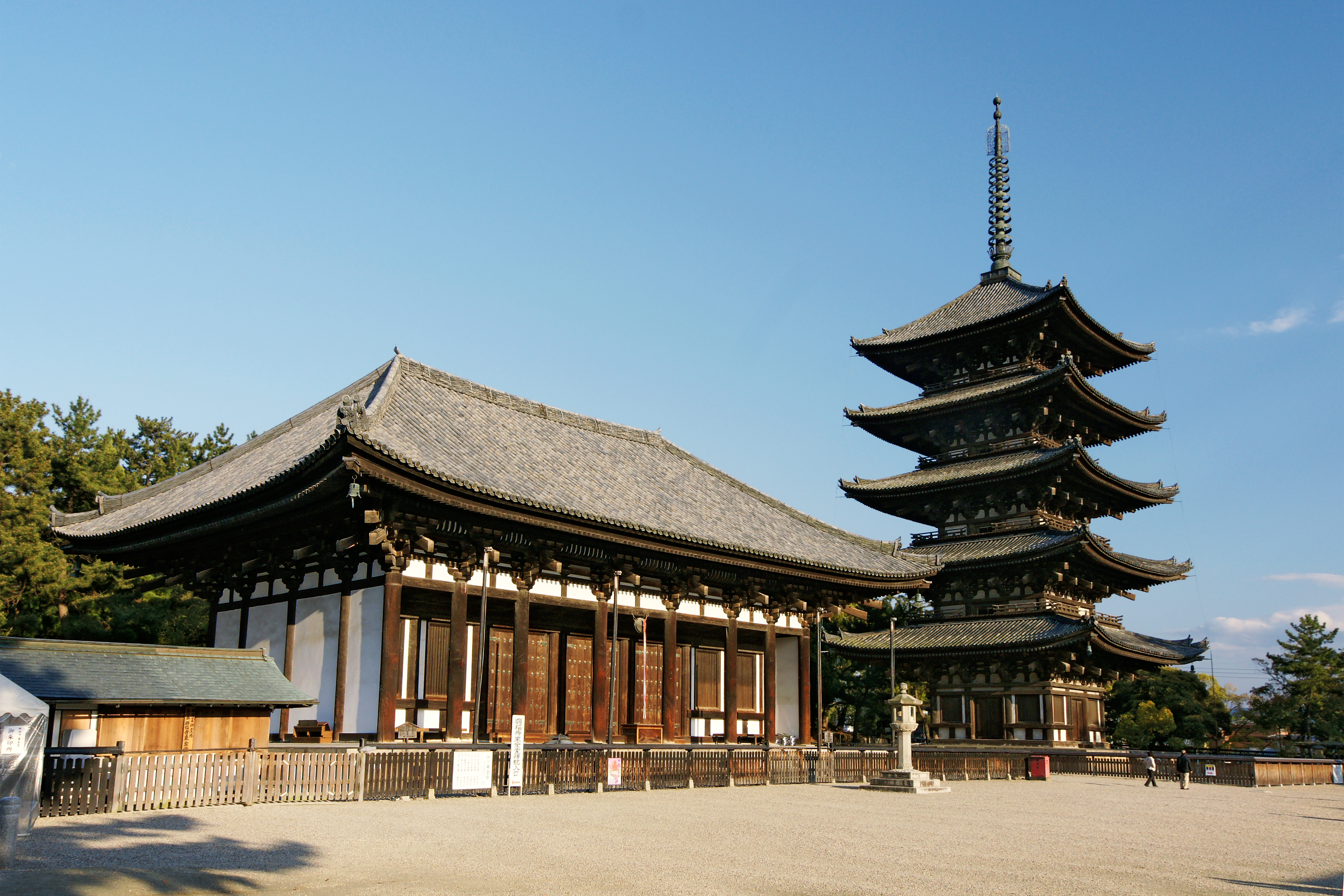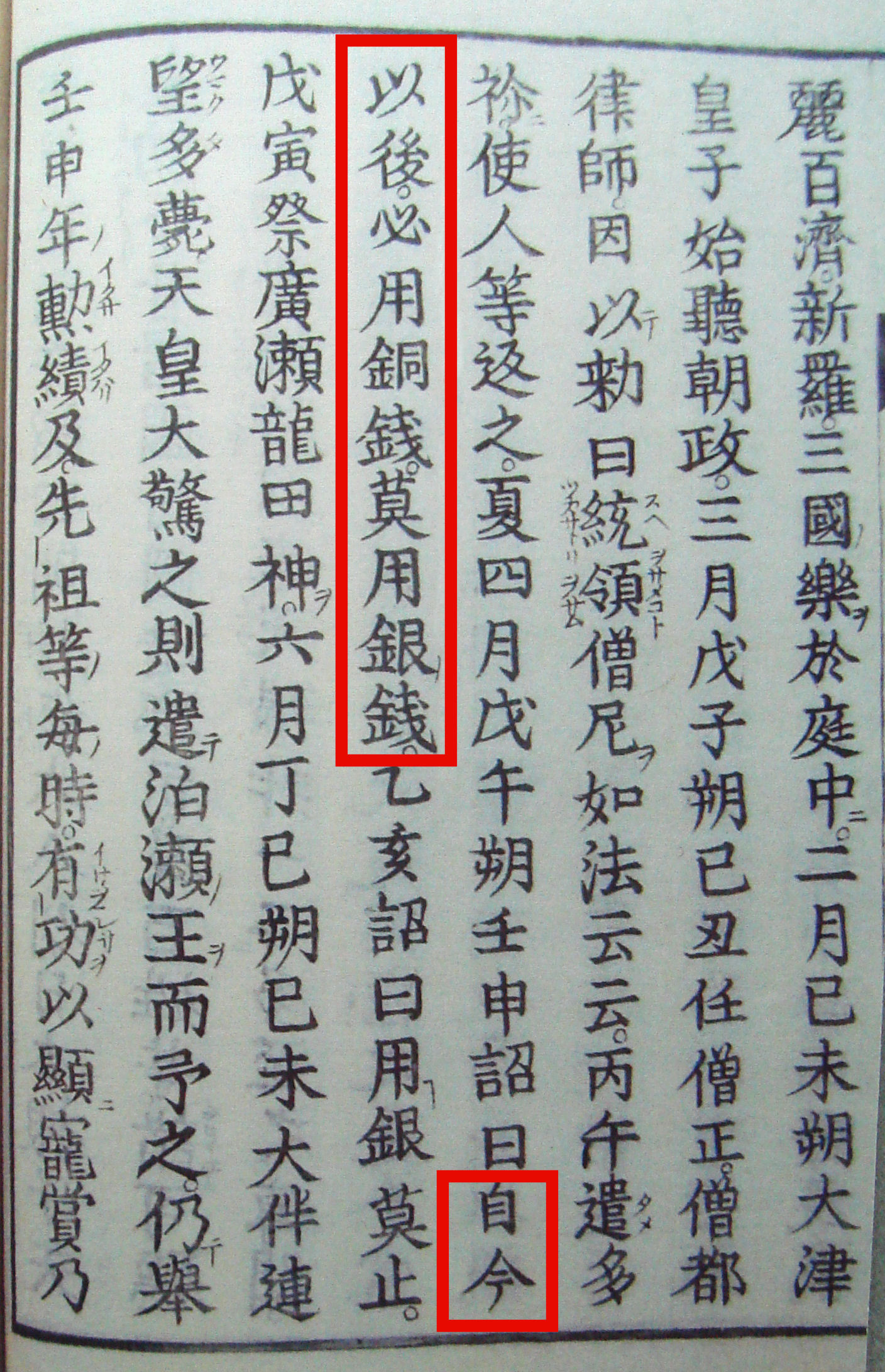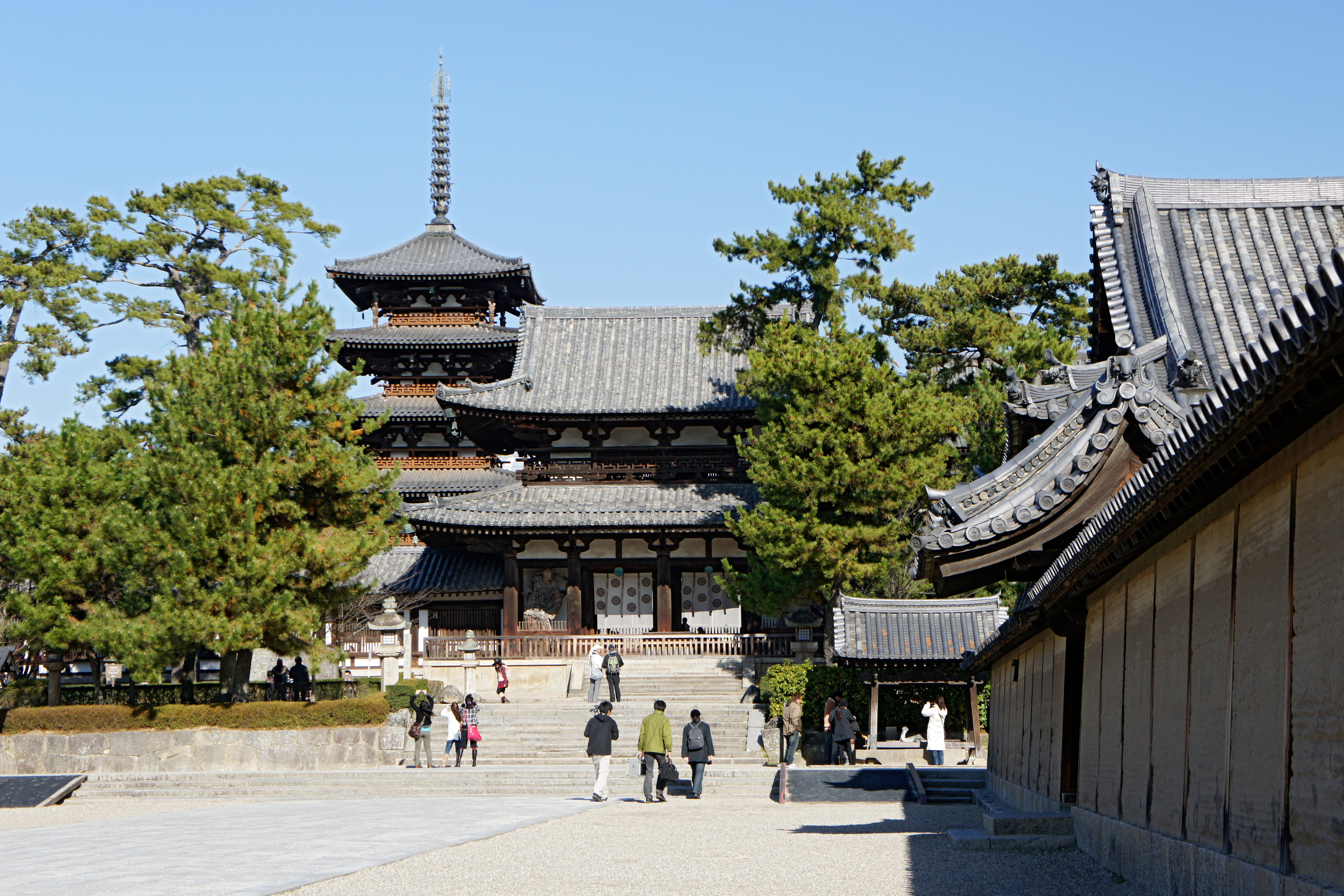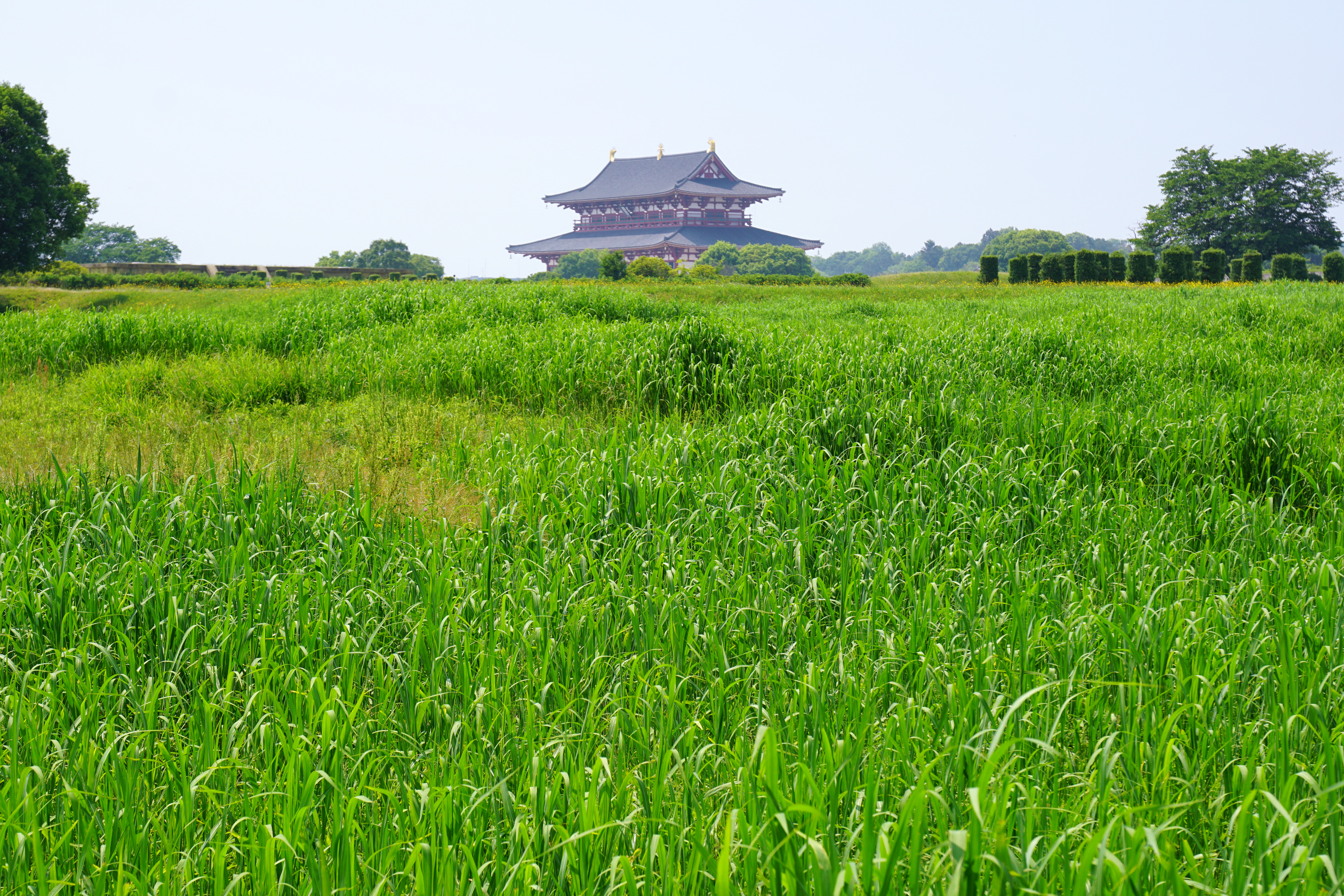|
Yakushi-ji
is one of the most famous imperial and ancient Buddhist temples in Japan, and was once one of the Seven Great Temples of Nanto, located in Nara. The temple is the headquarters of the Hossō school of Japanese Buddhism. Yakushi-ji is one of the sites that are collectively inscribed as a UNESCO World Heritage Site under the name of "Historic Monuments of Ancient Nara." The temple's main object of veneration, Yakushi Nyorai, also known as "The Medicine Buddha", was one of the first Buddhist Deities to arrive in Japan from China in 680, and gives the temple its name. History The Jinshin Wars in Japan in 672 resulted in moving the capital from Otsu back to Asuka. The movement of the capital was due to family disputes over money and power leading to civil war between Prince Naka and Prince Ōama. Prince Ōama desired power over Prince Naka's son, who was favored by his father to take the throne after him. After disagreements between Prince Ōama and Prince Naka's son, Prince Ōtomo ... [...More Info...] [...Related Items...] OR: [Wikipedia] [Google] [Baidu] |
Nara, Nara
is the capital city of Nara Prefecture, Japan. , Nara has an estimated population of 367,353 according to World Population Review, making it the largest city in Nara Prefecture and sixth-largest in the Kansai region of Honshu. Nara is a core city located in the northern part of Nara Prefecture bordering the Kyoto Prefecture. Nara was the capital of Japan during the Nara period from 710 to 784 as the seat of the Emperor before the capital was moved to Nagaoka-kyō, except for the years 740 to 745, when the capital was placed in Kuni-kyō, Naniwa-kyō and Shigaraki Palace. Nara is home to eight major historic temples, shrines, and heritage sites, specifically Tōdai-ji, Saidai-ji, Kōfuku-ji, Kasuga Shrine, Gangō-ji, Yakushi-ji, Tōshōdai-ji, and the Heijō Palace, together with Kasugayama Primeval Forest, collectively form the Historic Monuments of Ancient Nara, a UNESCO World Heritage Site. Etymology By the Heian period, a variety of different characters had ... [...More Info...] [...Related Items...] OR: [Wikipedia] [Google] [Baidu] |
Hakuhō Period
The was an unofficial of Emperor TenmuNussbaum, Louis-Frédéric. (2005). "''Hakuhō''" in ; n.b., Louis-Frédéric is pseudonym of Louis-Frédéric Nussbaum, ''see'Deutsche Nationalbibliothek Authority File. after '' Hakuchi'' and before '' Suchō''. The duration of this discrete non-''nengō'' timespan lasted from 673 through 686. The Hakuhō period is more often used as a general term which describes a wider range of years. History of art Hakuhō is conventionally used to identify a broad historical and artistic period of the late seventh century and early eighth century. The term is primarily used in art history and is thought to have been introduced at the 1910 Japan–British Exhibition. ''Hakuhou jidai'' 白鳳時代 [...More Info...] [...Related Items...] OR: [Wikipedia] [Google] [Baidu] |
Historic Monuments Of Ancient Nara
Historic Monuments of Ancient Nara is a UNESCO World Heritage Site consisting of eight places in the old capital Nara in Nara Prefecture, Japan. Five are Buddhist temples, one is a Shinto shrine, one is a Palace and one a primeval forest. The properties include 26 buildings designated by the Japanese Government as National Treasures as well as 53 designated as Important Cultural Properties. All compounds have been recognized as Historic Sites. The Nara Palace Site was designated as Special Historic Site and the Kasugayama Primeval Forest as Special Natural Monument. Tōdai-ji, Kōfuku-ji and the Kasugayama Primeval Forest overlap with Nara Park, a park designated as one of the "Places of Scenic Beauty" by the Ministry of Education, Culture, Sports, Science and Technology (MEXT). UNESCO listed the site as World Heritage in 1998. List of sites The table lists information about each of the 8 listed properties of the World Heritage Site listing for the Historic Monuments of An ... [...More Info...] [...Related Items...] OR: [Wikipedia] [Google] [Baidu] |
Emperor Temmu
was the 40th Emperor of Japan,Imperial Household Agency (''Kunaichō'') 天武天皇 (40) retrieved 2013-8-22. according to the traditional order of succession. Ponsonby-Fane, Richard. (1959). ''The Imperial House of Japan'', p. 53. He ascended to the throne following the Jinshin War, during which his army defeated that of Emperor Kōbun. Tenmu reigned from 673 until his death in 686, amid Hakuhō period or the late Asuka period. During his reign, Tenmu implemented political and military reforms, consolidating imperial power and centralizing governance. His foreign policy favored the Korean kingdom of Silla while severing diplomatic relations with the Tang dynasty of China. He used religious structures to bolster the imperial authority, building several Buddhist temples including Yakushi-ji and monasteries as well as strengthening ties with the Ise Shrine. He was succeeded by his wife, Empress Jitō. Tenmu is the first monarch of Japan contemporaneously documented as using th ... [...More Info...] [...Related Items...] OR: [Wikipedia] [Google] [Baidu] |
Mokoshi
In Japanese architecture , literally "skirt storey" or "cuff storey", is a decorative pent roof surrounding a building below the true roof. Since it does not correspond to any internal division, the ''mokoshi'' gives the impression of there being more floors than there really are. It is usually a '' ken'' deep and is most commonly seen in Buddhist temples and pagodas (see for example the article '' tahōtō''). The ''mokoshi'' normally covers a '' hisashi'', a walled aisle surrounding a building on one or more sides, but can be attached directly to the core of the structure (the '' moya''), in which case there is no ''hisashi''. The roofing material for the ''mokoshi'' can be the same or different (see for example's Hōryū-ji's ''kon-dō'') as in the main roof. Origin and purpose The name derives from the fact that it surrounds and hides the main building like the of a pair of pants.Shogakukan'Nihon Daihyakkasho, ''Mokoshi'' accessed on November 27, 2009 (in Japanese) Its pu ... [...More Info...] [...Related Items...] OR: [Wikipedia] [Google] [Baidu] |
Nara Prefecture
is a Prefectures of Japan, prefecture of Japan located in the Kansai region of Honshu. Nara Prefecture has a population of 1,321,805 and has a geographic area of . Nara Prefecture borders Kyoto Prefecture to the north, Osaka Prefecture to the northwest, Wakayama Prefecture to the southwest, and Mie Prefecture to the east. Nara (city), Nara is the capital and largest city of Nara Prefecture, with other major cities including Kashihara, Nara, Kashihara, Ikoma, Nara, Ikoma, and Yamatokōriyama. Nara Prefecture is located in the center of the Kii Peninsula on Japan's Pacific Ocean coast, and is one of only eight landlocked prefectures. Nara Prefecture has the distinction of having more UNESCO World Heritage listings than any other prefecture in Japan. History The Nara Prefecture region is considered one of the oldest regions in Japan, having been in existence for thousands of years, and is widely viewed as the Japanese cradle of civilization. Like Kyoto, Nara was one of Imperial ... [...More Info...] [...Related Items...] OR: [Wikipedia] [Google] [Baidu] |
Nara Period
The of the history of Japan covers the years from 710 to 794. Empress Genmei established the capital of Heijō-kyō (present-day Nara). Except for a five-year period (740–745), when the capital was briefly moved again, it remained the capital of Japanese civilization until Emperor Kanmu established a new capital, Nagaoka-kyō, in 784, before moving to Heian-kyō, modern Kyoto, a decade later in 794. Japanese society during this period was predominantly agricultural and centered on village life. Most of the villagers followed Shintō, a religion based on the worship of natural and ancestral spirits named ''kami.'' The capital at Nara was modeled after Chang'an, the capital city of the Tang dynasty. In many other ways, the Japanese upper classes patterned themselves after the Chinese, including adopting the Chinese writing system, Chinese fashion, and a Chinese version of Buddhism. Literature Concentrated efforts by the imperial court to record its history produced the f ... [...More Info...] [...Related Items...] OR: [Wikipedia] [Google] [Baidu] |
Heijō-kyō
was the Capital of Japan during most of the Nara period, from 710 to 740 and again from 745 to 784. The imperial palace is a listed UNESCO World Heritage together with other places in the city of Nara (cf. Historic Monuments of Ancient Nara). Empress Genmei ordered the Imperial capital moved from Fujiwara-kyō to Heijō-kyō in 708, and the move to Heijō-kyō was complete in 710. Heijō-kyō was modeled after Chang'an, the capital of Tang-dynasty China, although Heijō-kyō lacked walls. In the city, merchants and traders from China, Korea and India introduced various foreign cultures to Heijō-kyō through the Silk Road. As a result, Heijō-kyō flourished as Japan's first international and political capital, with a peak population of between 50,000 and 100,000. The overall form of the city was an irregular rectangle, and the area of the city was more than 25 km2. Architecture In the area of Heijō-kyō, there are ancient Buddhist temples, and some temples are ... [...More Info...] [...Related Items...] OR: [Wikipedia] [Google] [Baidu] |
Daian-ji
is a Buddhist temples in Japan, Buddhist temple located in the city of Nara, Nara , Nara, Nara Prefecture, Japan. It was founded by Emperor Jomei in 639 as one of the first official temples in Japan at the capital of Asuka-kyō and was subsequent relocated to Heijō-kyō with the relocation of the capital, where it became one of the Nanto Shichi Daiji, Seven Great Temples of Nara, Nara, Nara, Japan. It subsequently fell into decline and now is only a small fragment of its former size and importance. Its former precincts were designated a Monuments of Japan, National Historic Site in 1929. History The history of this temple is based on the ''Daianji Garan Engi'' and ''Ruki Shizaichō'' (''Daianji Zaichō'') from 747 and the ''Nihon Shoki'' and ''Shoku Nihongi''. According to these, when Prince Tamura (later Emperor Jomei) visited the sick Prince Shōtoku, he asked him to rebuild the Kumagoi Seisha as an official temple. By tradition, the Kumagoi Seisha was located in what is no ... [...More Info...] [...Related Items...] OR: [Wikipedia] [Google] [Baidu] |
Gangō-ji
290px, Model of Gangō-ji in the Nara period; the temple at the top of the photo is Kofuku-ji 290px, Site of the Five-story Pagoda was one of the first Buddhist temples in Japan, and was ranked as one of the powerful Seven Great Temples, in Nara, Japan. It was mostly destroyed in the Muromachi period and the old town of Naramachi occupies most of what was once the temple's precincts. Three small portions of the temple have survived to the present day, and each is now a separate temple. History With the relocation of the capital to Heijō-kyō in 710, the temples of Yakushi-ji, Umayasaka-ji (later Kofuku-ji), Daikandai-ji (later Daian-ji), and other temples in Asua were moved to the new capital. Hōkō-ji ( Asuka-dera) was also moved to Heijō-kyō in 718, but the original Hōkō-ji in Asuka was not abolished and remained in its original location. The temple in Asuka retained the name "Hōkō-ji" or "Hon-Gankō-ji," while the temple in Heijō-kyō was named "Gangō-j ... [...More Info...] [...Related Items...] OR: [Wikipedia] [Google] [Baidu] |
Fujiwara-kyō
280px, Map of Fujiwara-kyō was the Imperial capital of Japan for sixteen years, between 694 and 710. It was located in Yamato Province (present-day Kashihara in Nara Prefecture), having been moved from nearby Asuka, and remained the capital until its relocation to Heijō-kyō present-day Nara. It was the first in Japanese history to have been a planned city based on a square grid pattern modeled after the Chang'an, the capital of Tang dynasty China. History Per the ''Nihon Shoki'' in the 5th year of Emperor Tenmu's reign (676), the emperor began selecting the site of a new capital. Construction work was carried out over a number of years, based on the different standards of grid-like grids discovered during excavations, and was halted by the emperor's death. It was resumed in 690 under Empress Jitō and continued under the reigns of Emperor Mommu and Empress Genmei. Empress Genmei (661–721) moved the capital from Fujiwara-kyō to Nara (then Heijō-kyō) in 710 mainly t ... [...More Info...] [...Related Items...] OR: [Wikipedia] [Google] [Baidu] |








